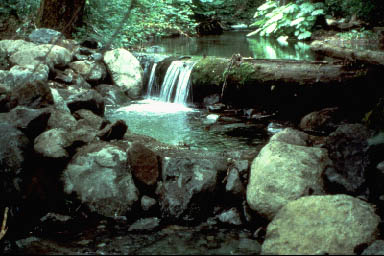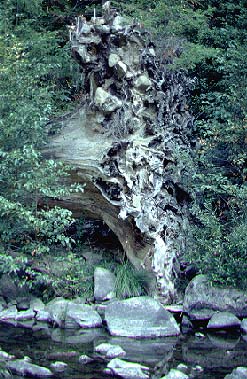Bibliography Background About KRIS
The Importance of Large Wood in Streams and Problems of Depletion
 Large trees which fall into coastal streams play a dominant role in forming pools, metering sediment, trapping spawning gravels and creating a more complex stream environment. Redwoods are particularly valuable because a large tree may not decay for several hundred years (Kelly et al., 1995). Fir and spruce trees last for several decades while alder and hardwood species rot within a few years of being recruited into the stream (Cedarholm et al., 1997). In general, the larger the size of the woody debris (as scientists call it), the greater its stability in the stream channel. Heavier pieces require higher flows for mobilization and longer pieces are more likely to be caught by the stream bank and its vegetation (Spence et al., 1996). Reeves et al. (1993) found "that wood is a primary element influencing habitat diversity and complexity in streams. Consequences of decreased amounts of wood include loss of cover and structural complexity, decreased availability and abundance of habitat units, and reduced varieties of current velocities and other hydraulic features."
Large trees which fall into coastal streams play a dominant role in forming pools, metering sediment, trapping spawning gravels and creating a more complex stream environment. Redwoods are particularly valuable because a large tree may not decay for several hundred years (Kelly et al., 1995). Fir and spruce trees last for several decades while alder and hardwood species rot within a few years of being recruited into the stream (Cedarholm et al., 1997). In general, the larger the size of the woody debris (as scientists call it), the greater its stability in the stream channel. Heavier pieces require higher flows for mobilization and longer pieces are more likely to be caught by the stream bank and its vegetation (Spence et al., 1996). Reeves et al. (1993) found "that wood is a primary element influencing habitat diversity and complexity in streams. Consequences of decreased amounts of wood include loss of cover and structural complexity, decreased availability and abundance of habitat units, and reduced varieties of current velocities and other hydraulic features."
Large wood is very important for forming pools in lower order streams (Kelly et al., 1995; Bisson et al., 1987) and pieces that span the channel can create dam pools or form complex jams which make excellent cover for salmonids. Spanning logs or jams may also trap pockets of stable spawning gravel. Pools help retain nutrients in the stream trapping organic debris and detritus (Sedell et al., 1988). The stair-steps pools formed by large wood in headwater streams increase the amount of slow-water habitat which is used by rearing juvenile salmonids (Sedell et al., 1988).
 Much of the large wood entering stream channels does so through landslides and debris torrents during large storm events. The wood component of debris torrents forms log jams, which may retain sediment for several years, thereby protecting lower reaches of the stream from sediment impacts. Poole and Berman (2000) note that large wood jams can also force stream flows underground and that this connection with the hyporheic zone can help cool stream temperatures. In intensively logged areas, debris torrents may lack large wood, so the torrents may have very long run-out distances and damage a far greater length of stream habitat (Pacific Watershed Associates, 1998). Large wood in headwater areas may also prevent headward erosion of gullies and stream channels (Kelly et al., 1995).
Much of the large wood entering stream channels does so through landslides and debris torrents during large storm events. The wood component of debris torrents forms log jams, which may retain sediment for several years, thereby protecting lower reaches of the stream from sediment impacts. Poole and Berman (2000) note that large wood jams can also force stream flows underground and that this connection with the hyporheic zone can help cool stream temperatures. In intensively logged areas, debris torrents may lack large wood, so the torrents may have very long run-out distances and damage a far greater length of stream habitat (Pacific Watershed Associates, 1998). Large wood in headwater areas may also prevent headward erosion of gullies and stream channels (Kelly et al., 1995).
Large wood both within and outside the low flow channel may play a crucial role in helping fish survive winter high flow conditions (Reeves et al., 1991). Large trees or root masses can provide slow back water areas during high flows and floods. This prevents young of the year coho and smaller steelhead juveniles from being swept down stream. Salmonid juveniles which are displaced from smaller streams when under optimal size survive poorly in larger river environments or in the ocean. Murphy et al. (1986) documented substantial decreases in over-wintering coho salmon in streams after clear cut logging in riparian zones.
The replenishment of large wood in stream channels depends upon recruitment from riparian areas. Kelly et al. (1995) noted that logging in riparian zones substantially decreases large wood in adjacent streams and that recruitment of woody material similar in diameter to old growth may take a century, even in redwood forests. McHenry et al. (1998) found that large wood in Olympic Peninsula streams decreased between 1983 and 1992. Although second growth trees were recruiting into the stream at a higher rate, the total volume of wood was decreasing. Even in riparian forests up to 73 years old, wood in the stream was smaller in diameter, more highly mobile and more subject to decay than in un-logged stream reaches. Bilby and Ward (1989) found that old growth derived large wood was depleted rapidly following logging and that the rate of loss of large wood was proportional to stream width. Losses of LWD were 22%, 47% and 86% for streams with widths of 5, 10 and 15 meters, respectively. In order to accelerate the recovery of optimal habitat conditions for salmon, Ligon et al. (1999) recommended more restrictive management of riparian buffers on private land in California.
Unfortunately, it is not possible to determine the amounts of large wood that were present in streams from existing stream survey data collected by the California Department of Fish and Game. The CDFG habitat survey protocol (CDFG, 1998) looks at wood within and along the stream channel, as a component of "cover", and cover is measured as a percent area for particular habitat units. Consequently, the only large wood data that were widely available from CDFG are in cumulative percentages of "cover", and can not be accurately summarized. Schuett-Hames et al. (1999) have suggestions for more repeatable, standardized monitoring of large wood in streams.
References
Bilby, R. E., and J. W. Ward. 1989. Changes in characteristics and function of woody debris with increasing size of streams in western Washington. Transactions of the American Fisheries Society 118: 368-378.
Bisson, P. A., R. E. Bilby, M. D. Bryant, C. A. Dolloff, G. B. Grette, R. A. House, M. L. Murphy, K. V. Koski, and J. R. Sedell. 1987. Large woody debris in forested streams in the Pacific Northwest: past, present and future. Pages 143-190 in E.O. Salo and T.W. Cundy, editors. Streamside Management Forestry and Fishery Interactions. Univ. of Wash., Institute for Forest Resources, Contribution 57, Seattle, WA.
CA Department of Fish and Game. 1998. California Salmonid Stream Habitat Restoration Manual. Third Edition. Inland Fisheries Division. California Department of Fish and Game. Sacramento, CA. 495 pp.
Cedarholm, C.J., R.E. Bilby, P.A. Bisson, T.W. Bumstead, B.R. Fransen, W.J. Scarlett and J.W. Ward. 1997. Response of Juvenile Coho Salmon and Steelhead to Placement of Large Woody Debris in a Coastal Washington Stream. North American Journal of Fisheries Management. 17:947-963.
Kelly, E.A., A. MacDonald, T. Tally and N.J. Merrit. 1995. Effects of Large Organic Debris on Channel Morphology and Sediment Storage in Selected Tributaries of Redwood Creek, Northwestern, California. U.S. Geologic Survey Professional Paper 1454-P, Menlo Park, CA. 29 p.
Ligon, F., A. Rich, G. Rynearson, D. Thornburgh, and W. Trush. 1999. Report of the Scientific Review Panel on California Forest Practice Rules and Salmonid Habitat. Prepared for the Resources Agency of California and the National Marine Fisheries Service. Sacramento, CA. 181 pp.
McHenry, M.L., E. Shott, R.H. Conrad, and G.B. Grette. 1998. Changes in the quantity and characteristics of large woody debris in streams of the Olympic Peninsula, Washington, USA (1982-1993). Can. J. Fish. Aquat. Sci. 55: 1395-1407. June.
Murphy, M.L., J. Heifitz, S.W. Johnson, K.V. Koski, and J.F. Thedinga. 1986. Effects of clear-cut logging with or without buffer strips on juvenile salmonids. In Alaskan streams. Canadian Journal of Fisheries and Aquatic Sciences 43:1521-1533.
Pacific Watershed Associates. 1998. Sediment Source Investigation and Sediment Reduction Plan for the Bear Creek Watershed, Humboldt County, California. Prepared for The Pacific Lumber Company Scotia, California. Arcata, California. 57 pp.
Poole, G.C., and C.H. Berman. 2000. Pathways of human influence on water temperature dynamics in stream channels. Environmental Management. 20 pp.
Reeves, G.H., J.D. Hall, T.D. Roelofs, T.L. Hickman, and C.O. Baker. 1991. Rehabilitating and modifying stream habitats. Pages 519-557 in W.R. Meehan, editor. Influences of Forest and Rangeland Management on Salmonid Fishes and Their Habitats. American Fisheries Society, Special Publication 19, Bethesda, Md.
Reeves, G. H., F. H. Everest, and J. R. Sedell. 1993. Diversity of juvenile anadromous salmonid assemblages in coastal Oregon basins with different levels of timber harvest . Transactions of the American Fisheries Society. 122(3): 309-317. [119kb]**
Schuett-Hames, D., A. et al. 1999. TFW Monitoring Program method manual for the large woody debris survey. Prepared for the Washington State Dept. of Natural Resources under the Timber, Fish, and Wildlife Agreement. TFW-AM9-99-004. DNR #106. Seattle, WA. 66 pp. [2.21Mb]
Sedell, J. R., P. A. Bisson, E J. Swanson, and S. V. Gregory. 1988. What we know about large trees that fall into streams and rivers. Pages 47-81 in C. Maser, R. F. Tarrant, J. M. Trappe, and J. E Franklin, From the forest to the sea: a story of fallen trees. U.S. Forest Service General Technical Report PNW-GTR-229.
Spence, B.C., G.A. Lomnicky, R.M. Hughes and R. P. Novitzki. 1996. An Ecosystem Approach to Salmonid Conservation. Funded jointly by the U.S. EPA, U.S. Fish and Wildlife Service and National Marine Fisheries Service. TR-4501-96-6057. Man Tech Environmental Research Services Corp., Corvallis, OR. http://www.nwr.noaa.gov/1habcon/habweb/ManTech/front.htm#TOC
Stillwater Sciences. 1997. A review of coho salmon life history to assess potentially limiting factors and the implications of historical removal of large woody debris in coastal Mendocino County. Prepared by Stillwater Sciences, Berkeley CA for Louisiana-Pacific Corporation, Wildlife and Fisheries Science Group, Forest Resources & Fiber Procurement Division. May 1997. 55 pp
